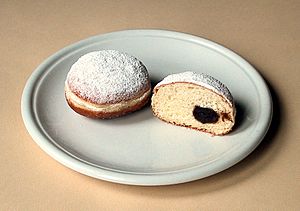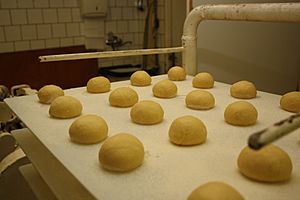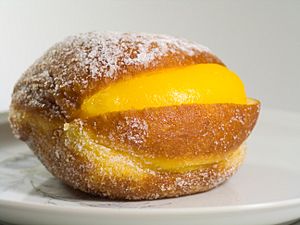Berliner (doughnut) facts for kids

A Berliner is a yummy type of doughnut that comes from Germany and other parts of Central Europe. It's a popular sweet treat enjoyed by many!
Berliners are made from a sweet yeast dough that is fried until golden brown. They usually have a tasty marmalade or jam filling inside. On top, you'll often find icing, powdered sugar, or regular sugar. Sometimes, they are filled with other delicious things like chocolate, champagne, custard, or even advocaat. The filling is put inside after the doughnut is fried, using a special tool.
Contents
What's in a Berliner?
Berliners are made from a soft, sweet dough. This dough is fried in hot oil, which makes it light and fluffy. After frying, a special machine or a large syringe is used to inject the filling into the middle of the doughnut. This way, every bite has a burst of flavor!
Different Names Around the World
This delicious doughnut has many different names depending on where you are!
In Germany
- Most places in Germany call it a Berliner.
- But in Berlin, Brandenburg, and Saxony, people call them Pfannkuchen. This can be a bit confusing because in the rest of Germany, Pfannkuchen usually means pancakes! In those areas, pancakes are called Eierkuchen.
- In parts of southern Germany (Bavaria) and much of Austria, they are known as a type of Krapfen.
- In Hesse, they are called Kräppel or Kreppel.
- In Rhineland-Palatinate, they are sometimes called Fastnachtsküchelchen, which means "little carnival cakes."
Beyond Germany
Berliners are popular in many countries, often with their own unique names:
- In South Tirol (northern Italy), they are called krafen or krapfen.
- In Slovenia, it's a krof.
- In Croatia, they are krafne.
- In Bosnia and Serbia, they are also krofne.
- In Poland, they are known as pączki.
- The Czech Republic calls them kobliha.
- In Hungary, it's a fánk.
All these treats are very similar to the Berliner!
Berliners in English-Speaking Countries
In countries where English is spoken, Berliners are usually just called doughnuts. They are often filled with jam, jelly, custard, or whipped cream.
- In South Australia, there's a special kind called the Kitchener bun. It's a Berliner that's cut on the side and filled with jam and cream.
- In North America, the most common name for a jam- or jelly-filled Berliner is "jelly doughnut." The jam used for these doughnuts is often made a bit differently, so it stays soft and doesn't set like regular jam.
- Doughnuts filled with cream or custard often have chocolate icing. They might be called Bavarian cream or Boston cream doughnuts. The Boston cream doughnut is even the official state doughnut of Massachusetts!
- In parts of Canada (like Ontario and the prairie provinces) and the Midwest U.S., a round, filled doughnut is often called a "Bismarck." A longer, bar-shaped filled doughnut is called a "Long John."
- Other Canadian names include "jambuster" in Manitoba and "Burlington bun" in Nova Scotia.
Traditions and Fun Facts
Berliners are often eaten during special celebrations.
- They are a traditional treat on New Year's Eve (called Silvester in Germany).
- They are also very popular during carnival holidays, like Mardi Gras.
A funny practical joke that Germans sometimes play is to secretly fill some Berliners with mustard instead of jam! They then serve them mixed with the regular ones, waiting for someone to get a surprise bite!
Berliners Around Latin America and Israel
- In Portugal, Berliners are called bolas de Berlim (Berlin ball). They are usually a bit bigger than German ones. They are always filled with a yellow, egg-yolk cream called creme pasteleiro. The cream is put in after the doughnut is cut in half, so you can always see the yummy filling! They are sprinkled with regular sugar.
- Similar versions are found in Latin America, like in Chile, Uruguay, and Argentina. Here, they are filled with custard (called "Crema pastelera"), jam, or manjar blanco (a type of milk caramel).
- In Brazil, Berliners are called sonhos (which means "dreams"). They are traditionally filled with yellow cream. Some modern versions might have doce de leite (a milk jam) or a mix of chocolate and doce de leite.
- In Israel, a version of the pastry called sufganiyah is eaten during the holiday of Hanukkah. While they are usually filled with jam, many new and exciting fillings exist today!
Related pages
Images for kids
-
The Kitchener bun is a Berliner cut on the side for the filling of jam and cream.
See also
 In Spanish: Berlinesa para niños
In Spanish: Berlinesa para niños




